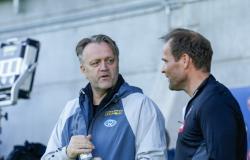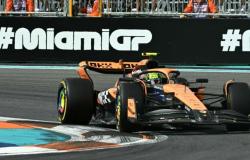Written by Karsten Pedersen, football coach
HIL has started as expected. 6 points out of 6 possible, which is a very good start. A tough match against Skjervøy awaits.
I saw the match against Glimt 2, who tried to play as their A team, but in a lower gear the intentions were relatively easy to read. HIL secured themselves by staying in front of their own goal with most of their players throughout the 2nd half. Perhaps not absolutely necessary. It looked like you were playing against an elite team, you were compact and united, which was probably how they had thought and planned, so in that sense they achieved what they were trying for. They were undoubtedly looking for the good counter-attacking opportunities. Glimt therefore rarely entered the back room directly in front of HIL’s goalkeeper. Some might say that there wasn’t much room at the back, and you can probably agree with that. The Glimt team looked very young, perhaps it was a junior team from the club’s own academy? But in any case, they are part of the department and the fights against them must of course be taken seriously. Before, it was probably the case that the reserves on the A team formed part of the 2nd team in the match situation, but it didn’t look like that this time. So that must mean that those who make up the A-squad from 16-24 do not have a satisfactory battle arena in Glimt?
I have recently attended some A team training sessions in Glimt where the pace of the game sequences really impressed me. Definitely the best I have seen from Norwegian elite teams. The pace from training can be recreated in the right match situation. How will our local senior teams produce a higher match tempo? Simple recipe at maximum speed. There is development in that. Jacob Klæboe Pedersen’s counterattack was taken straight from the textbook. Glorious.
From the stands mused I wondered where there would be room for Glimt’s own academy players at such an A training session and in Glimt’s squad those I had seen in two matches the day before. It looked reasonably tight in terms of skill. You are well coordinated, and most have above average good functional skills. Yes, some certainly at a good international level. From the stands, I see Patrick Berg and Grønbæk excel. Now Patrick is the grandson of himself, so it is more than natural that he is really good rather than just average. And I am so old that I myself remember Harald Berg in matches at Blåbærhaugen against HIL. My old heroes from HIL’s A-team at the time, who were undoubtedly good, have to excuse me, Harald held an exhibition with the ball in his feet fully on par with the “North Norwegian”, a recognized art exhibition in the region.
What a wonderful skills family they have been in for a total of almost 60 years. My favorite there was Arild Berg. He was neither big, strong nor particularly fast, but he had everything we associate with individual and relational football skills to such an extent and level that he had solutions for every situation. Good solutions, which filled the stands, and with an international touch. It’s always fun to see how the best get out of difficult situations. He was like that.
The solutions that one can better discover from a grandstand position. Arild saw all good ground level with chasing opponents chasing after him when he advanced up the pitch. Which played through both one and two pressure joints completely naturally and effortlessly. Unfortunately, we do not see such types today. Where did Arild, Patrick, Ørjan, Runar and Harald get their enormous joy of playing? I think they loved the game and could play and play for a long time.
I often wonder on whether we in Harstad are betting on the wrong methodology when working with young players. If you have the ball in everything you do, we play enough, there is too much instruction and you hit the right moments with the moments you are looking for. And let’s say that the players manage the moments that the coach chooses to prioritize this session. Then it’s over in the game, at the end of training. And the moments are followed up from the sidelines, and perhaps the coach is so confident that he enters the pitch to demonstrate what he thinks should happen. What about all the local “Messies”, “Mardonas”, “Arild Bergen”, “Laudrupes”, and everyone else at that level who was allowed to dribble in such a way that they got their characteristic dribbling skills. And nobody can claim that they were bad passers because they were good dribblers. They were masters here too. A little too many times I’ve seen players get locked into tasks that shouldn’t have been given. Dribblers must be stimulated to dribble even more, and that permission is what the coach must give, loudly and repeatedly.
As elsewhere in in most environments, work is done eagerly and with passion here in the area. There is no doubt about that. Children and young people are well looked after. But why do I think that it is of course great to have 3 new points for HIL, but at the same time I think that there is no lack of skills here? Yes, there is a lack and almost no one plays football in a natural way. And what do I think about then? They manage to move with the ball under control in an effortless way and make small changes of direction at the right moment, they release pressure easily, the passing options are scanned quickly and the pass comes at the right time, not too early and not too late, they position themselves correctly and easily turns up in the middle zone. Reading the climate is supposed to be a good thing.
I think like always rule that you play the ball in support far too much. The flow of a well-started attack stops completely, and then it’s back to starting over. The natural skills can, as always, only be achieved through a lot of play. Here I believe the intersection always lies in all football training. A lot of free play organized by the players themselves with some practical help from adults versus organized, and that’s it. How to become good, or exceptionally good? The foundation is primarily laid in the age group 6–14 years. Here it has to be played and almost only that. Pushing on with exercises with additional instructions is a bummer, anyway. The coach’s main task here will rather be to create joy in the game and introduce free football, and to follow this up with real interest. Then you will be amply repaid through players with natural skills who enter their youth with an applied and acquired joy of playing. And the best, having acquired skills that will stand up when you are introduced, and try them out, at a high level. After all, the best are very good at basic functional skills. You have played well. The joy of playing does not come by itself, and probably not if you participate in matches with far too many players involved.
It is first as you can expect and hope that you can play your way up in the divisions with locally educated players. Micro football must come before macro football, old Liedholm said. So 4 against 4 and thereabouts, long before 11 against 11. Continuous contact with the ball and opportunities to finish is something different than a touch of the ball every 6 minutes as a right back in 9 against 9, or 7 against 7 for that matter. Still in the 6–14 age group.
In major championships we observe that Brazilian players are always good ball handlers, completely effortless. Could it be because they have played a lot in their spare time when they were young, and even without a coach present? Is it possible?
Tags: Harstad betting wrong methodology
-





